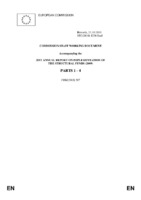| dc.description.abstract | As required by Article 45(2) of Council Regulation (EC) No 1260/1999, this report sets out to give an overview of the implementation of the Structural Funds (2000-2006) in 2009. 2009 was the tenth year in which Structural Funds programmes and projects for the 2000-2006 programming period were implemented. Altogether 226 Objective 1 and Objective 2, 47 Objective 3, 12 Financial Instrument for Fisheries Guidance (FIFG) (outside Objective 1), 81 INTERREG, 71 URBAN, 27 EQUAL, 73 LEADER+ and 181 Innovative Action programmes were managed in 2009. Even though no further commitments could be made in 2009, sums were disbursed in respect of 2000-2006 Structural Funds assistance. Implementation of the 2009 budget was very good. In terms of payment appropriations, 100.0%of the European Regional Development Fund (ERDF), 97.0% of the European Social Fund (ESF), 97.9% of the European Agricultural Guidance and Guarantee Fund (EAGGF)-Guidance budget available at the end of 2009 (after a reduction of EUR 417.9 million — see section 2.1.3 below) and 69.5% of FIFGresources were used (compared to 99.9% ERDF, 98.0% ESF, 97.2% EAGGF and 97.8% FIFG in 2008). Member States and regions whose programmes have high absorption rates were able to start preparing for closure. The general framework for the closure of 2000-2006 Structural Funds assistance was set out in Commission Decision C(2006)3424 in 2006, amended by Commission Decisions C(2008)1362 and C(2009)960. In view of the financial crisis and the recovery package proposed by the Commission, an extension of six (or twelve) months has been granted on a programme-by-programme basis for those Member States which opted for it. Altogether 385 programmes have chosen to extend their final date of eligibility. This flexibility should allow full implementation of the allocated funds by addressing unexpected programme absorption challenges and, consequently, achieve the objectives of the programmes. In addition to the implementation of 2000-2006 Structural Funds programmes and projects and preparation for their closure, in 2009 the Commission was also heavily involved in implementing 434 programmes (317 ERDF, 117 ESF)1 for the 2007-2013 period. The partnership model, set up between the Commission and the national and regional authorities in the Member States to implement the programmes, has produced very high-quality results. |

